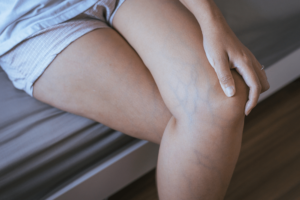| Sclerotherapy tackles varicose and spider veins, those unwanted visible or bulging veins. This minimally invasive vein treatment injects a solution to collapse the veins, improving appearance and reducing discomfort. While some minor and temporary side effects exist, sclerotherapy offers a safe and effective approach. Are you ready to reclaim smooth legs and newfound confidence? Schedule a consultation at Miami Vein today! |
Varicose and spider veins can be a constant source of frustration, impacting both aesthetics and comfort. But fear not! Sclerotherapy offers a minimally invasive solution for these unwanted veins. This blog delves into the world of sclerotherapy, exploring its mechanism of action, treatment applications, and the benefits it can offer.
We’ll also address potential risks and aftercare tips to ensure a smooth recovery. Whether you’re considering sclerotherapy or simply want to learn more about this treatment option, this comprehensive guide will equip you with the knowledge you need.
What Is Sclerotherapy & How Does It Work?
Sclerotherapy involves injecting a solution directly into compromised veins, causing them to collapse and eventually fade away. The solution irritates the lining of the blood vessels, causing them to stick together and form a clot. Over time, the body naturally absorbs the clotted veins, improving the appearance of the treated area.
The procedure is performed by a healthcare professional, usually a vein specialist. It is typically done on an outpatient basis and does not require general anesthesia. The duration of the procedure depends on the number and size of the veins being treated.
What Is Sclerotherapy Used To Treat?
Sclerotherapy is primarily used to treat varicose veins and spider veins. Varicose veins are enlarged, twisted veins that often appear blue or purple. They can be painful and may cause symptoms such as aching, throbbing, and swelling.
Spider veins, on the other hand, are smaller, red, or blue veins that are closer to the surface of the skin. They are typically not painful but can be cosmetically bothersome. In addition to treating varicose veins and spider veins, sclerotherapy can also be used to treat other conditions such as hemorrhoids and hydroceles.
It is important to consult with a healthcare professional to determine if sclerotherapy is the appropriate vein treatment option for your specific condition.
Benefits of Sclerotherapy
Sclerotherapy offers several benefits for individuals with varicose veins or spider veins, which it is most commonly used to treat. When compared to other treatment methods, Sclerotherapy proves to be the most efficient option.
Some of the key benefits of the procedure include:
- Improved appearance: Sclerotherapy can significantly reduce the appearance of varicose veins and spider veins, improving the overall appearance of the affected area.
- Symptom relief: Sclerotherapy can alleviate symptoms such as pain, swelling, and discomfort associated with varicose veins and spider veins.
- Non-surgical: Sclerotherapy is a non-surgical procedure, which means there is no need for general anesthesia or a hospital stay. It can be performed on an outpatient basis.
- Quick recovery: Most people can resume their normal activities immediately after the procedure, with minimal downtime or recovery period.
- High success rate: Sclerotherapy has a high success rate in treating varicose veins and spider veins, with long-lasting results in most cases.
It is important to note that the specific benefits of sclerotherapy may vary depending on the individual and their specific condition.
Potential Risks and Side Effects
While sclerotherapy is generally considered a safe procedure, there are some potential risks and side effects to be aware of. Most of the issues which can arise from sclerotherapy are minor discomforts and are temporary but when considering a procedure, it’s important to learn as much as you can about the risks.
These may include:
- Temporary discomfort: Some people may experience temporary discomfort or pain at the injection site. This usually resolves on its own and can be managed with over-the-counter pain relievers.
- Bruising: It is common to experience bruising or discoloration at the injection site. This usually fades over time.
- Swelling: Swelling of the treated area is also common and typically resolves within a few days.
- Allergic reaction: Although rare, you may have an allergic reaction to the sclerosing solution used in the procedure. It is important to inform your healthcare professional about any known allergies before undergoing sclerotherapy.
- Blood clot formation: In rare cases, blood clots may form in the treated veins. This can be managed with medication and close monitoring by a healthcare professional.
- Skin discoloration: Some people may experience temporary or permanent skin discoloration in the treated area. This is more common in individuals with darker skin tones.
It is important to discuss the potential risks and side effects of sclerotherapy with a healthcare professional before undergoing the procedure.
Sclerotherapy Recovery and Aftercare Tips
After undergoing sclerotherapy, it is important to follow the recommended recovery and aftercare tips to ensure optimal results and minimize any potential complications.
Some general tips include:
- Wearing compression stockings: Your healthcare professional may recommend wearing compression stockings for a certain period of time after the procedure. These stockings help promote blood flow and reduce swelling.
- Avoiding strenuous activities: It is advisable to avoid strenuous activities, such as heavy lifting and vigorous exercise, for a few days after the procedure.
- Taking over-the-counter pain relievers: If you experience any discomfort or pain, you may take over-the-counter pain relievers as recommended by your healthcare professional.
- Avoiding hot baths or saunas: It is best to avoid hot baths or saunas for a few days after the procedure to prevent excessive heat on the treated area.
- Following up with your healthcare professional: It is important to schedule a follow-up appointment with your healthcare professional to monitor your progress and address any concerns or questions you may have.
These are general guidelines, and your healthcare professional may provide specific instructions based on your individual case. It is essential to follow their advice for a smooth recovery.
Explore Sclerotherapy As A Solution To Your Vein Issues With Miami Vein
Sclerotherapy offers a safe and effective approach to reclaiming smooth, beautiful legs and newfound confidence.
At Miami Vein, our team of experienced vascular specialists is dedicated to providing personalized treatment plans tailored to your unique needs. We’ll help you explore if sclerotherapy is the right choice for you and guide you through every step of the process.
Schedule a consultation with Miami Vein today and take the first step towards a healthier, happier you!
Frequently Asked Questions
1. How long does a sclerotherapy session usually take?
The duration of a sclerotherapy session depends on the number and size of the veins being treated. It can range from 15 minutes to an hour.
2. Is sclerotherapy painful?
Most individuals experience only minimal discomfort during the procedure. A slight burning or stinging sensation may be felt when the solution is injected into the veins.
3. How many sclerotherapy sessions are needed to achieve the desired results?
The number of sclerotherapy sessions required varies depending on the severity of the veins and the individual’s response to the treatment. Multiple sessions may be needed to achieve the desired results.
4. Are the results of sclerotherapy permanent?
Sclerotherapy can significantly reduce the appearance of varicose veins and spider veins, but it does not guarantee permanent results. New veins may develop over time, especially if the underlying cause of the veins is not addressed.
5. Are there any restrictions after sclerotherapy?
Your healthcare professional may provide specific restrictions based on your case. In general, it is advisable to avoid prolonged sitting or standing, as well as exposure to direct sunlight or tanning beds for a few days after the procedure.


